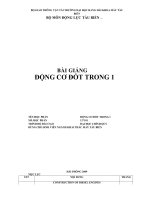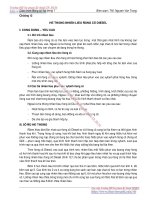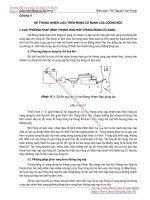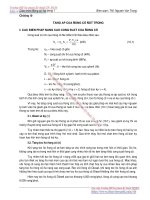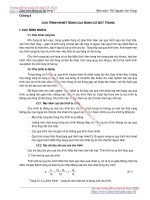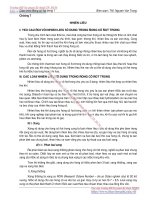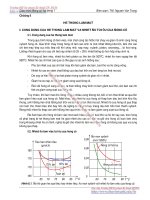bài giảng chi tiết động cơ đốt trong 1
Bạn đang xem bản rút gọn của tài liệu. Xem và tải ngay bản đầy đủ của tài liệu tại đây (1.5 MB, 52 trang )
BỘ GIAO THÔNG VẬN TẢI TRƯỜNG DẠI HỌC HANG HẢI KHOA MÁY TÀU
BIỂN
BỘ MÔN ĐỘNG LỰC TÀU BIỂN • • •
BÀI GIẢNG
ĐỘNG CƠ ĐỐT TRONG 1
TÊN HỌC PHÀN ĐỘNG CƠ ĐÓT TRONG 1
MÃ HỌC PHẦN 12*101
TRÌNH ĐỘ ĐÀO TẠO ĐẠI HỌC CHÍNH QUY
DÙNG CHO SINH VIÊN NGÀNH KHAI THÁC MÁY TÀU BIÉN
HẢI PHÒNG 2009
MỤC LỤC
STT NỘI DUNG TRANG
CONSTRUCTION OF DIESEL ENGINES
1 Operational principle of diesel engines
1.1 The history of developments of diesel engines 7
1.2 Basic definitions, that used for a diesel engine 8
1.3 Operational principle of 4-stroke diesel engines 10
1.4 Operational principle of 2-stroke diesel engines 11
1.5 Comparison between 4-stroke and 2-strokc diesel engines 13
1.6 Timing diagram of gas exchange phases of diesel engines 13
1.7 Classification of internal combustion engines 15
Review questions 17
2 Static parts construction of diessel engines
2.1 Bedplates 18
2.2 Main bearings 20
2.3 Engine frames (frameworks) 24
2.4 Cylinder blocks and cylinder liners 25
2.5 Cylinder covers 29
Review questions 31
3 Moving parts construction of diesel engines
3.1 Piston groups 32
3.2 Connecting rods 41
3.3 Crankshaft 43
Review questions 47
4 Cơ câu trao đôi khí
4.1 Chức năng và yêu câu của cơ câu trao đôi khí 48
4.2 Sơ đô cơ câu trao đôi khí dân động cơ giới 49
Câu hói ôn tập 52
5 Hệ thông nhiên liệu động CO' diesel
5.1 Chức năng và yêu câu cùa hệ thông nhiên liệu 54
5.2 Phân loại hệ thông nhiên liệu 54
5.3 Cung câp nhiên liệu cho chu trình 57
5.4 Các thiêt bị chính của hệ thông nhiên liệu 59
Câu hỏi ôn tập 64
Hệ thông bôi tron
6 6.1 Giới thiệu chung 66
6.2 Dâu bôi trơn và các thiêt bị chính cúa hệ thông bôi trơn 71
Câu hỏi ôn tập 73
7 Hệ thông làm mát
7.1 Giới thiệu chung 74
7.2 Các hệ thông làm mát động cơ diesel 75
7.3 Các thiêt bị chính cùa hệ thông làm mát 76
Câu hỏi ôn tập 77
8 Hệ thông khỏi động và đảo chiêu
8.1 Hệ thông khởi động 78
8.2 Hệ thông đảo chiêu 83
Câu hỏi ôn tập 84
9 Động cơ diescl thâp tôc cở lớn
9.1 Đặc điêm kêt câu 85
STT NỘI DUNG TRANG
9.2 Cơ câu trao đôi khí 89
9.3 Hệ thông cung càp nhiên liệu 89
Câu hỏi ôn tập 90
Môt sô đê thi tham khảo 91
Đáp án ỉham khảo 96
2
YÊU CẦU VÀ NÔI DUNG CHI TIÉT
Tên học phần: Động cơ đốt trong 1 Loại học phần: 2
Bộ môn phụ trách giảng dạv: Động lực tàu biển Khoa phụ trách: MTB
Mã học phần: 12101 Tổng số tín chỉ: 4
TS tiêt Lý thuyêt Thưc hành Tư hoc Bài tập lớn Đô án môn hoc
75 45 30 0 0 0
Điều kiện tiên quyết: Trước khi đăng ký học học phần này, sinh viên phải học và thi đạt các học
phần sau: Nguycn lý máy; Chi tiết máy; Nhiệt kỹ thuật.
Mục tiêu của học phần: Cung cấp cho sinh viên kiến thức về kết cấu cơ bản động cơ dicsel tàu thủy,
các hệ thống phục vụ cho động cơ dicsel, kỹ năng khai thác động cơ diescl cũng như các hệ thống phục vụ
của nó.
Nội dung chủ yếu:
- Nguyên lý hoạt động cùa động cơ diesel;
- Ket cấu của động cơ diesel;
- Cơ cấp phân phối khí;
- Các hệ thống phục vụ động cơ diesel và kỹ năng khai thác chúng.
Nội dung chi tiết:
NỘI DUNG PHÂN PHÓI THỜI GIAN (tiết)
Lý
thuyết
Thực
hành
Bài ỉập
lớn
Tổng
số
CONSTRUCTION OF DIESEL ENGINES 45 30 75
Chapter 1. Operational principle of diesel engines 6.0 6.0
1.1 The history of developments of diesel engines 0.5
1.2 Basic definitions, that used for a diesel engine 0.5
1.3 Operational principle of 4-stroke diesel engines 1.5
1.4 Operational principle of 2-stroke diesel engines 1.0
1.5 Comparison between 4-stroke and 2-stroke diesel engines
0.5
1.6 Timing diagram of gas exchange phases of diesel engines
1.0
1.7 Classification of internal combustion engines 1.0
Chapter 2. Static parts construction of diessel engines 4.0 5.0 9.0
2.1 Bedplates 0.5
2.2 Main bearings 1.0
2.3 Engine frames (frameworks) 0.5
2.4 Cylinder blocks and cylinder liners 1.5
2.5 Cylinder covers 0.5
Chapter 3. Moving parts construction of diesel engines 5.0 5.0 10.0
3.1 Piston groups 3.0
3.2 Connecting rods 1.0
3.3 Crankshaft 1.0
Chưoììg 4. Co' câu trao đôi khí 4.0 4.0 8.0
3
4.1 Chức năng và yêu cầu cùa cơ cấu trao đôi khí 0.5
4.2 Sơ đô cơ câu trao đôi khí dân động cơ giới 3.5
Chưoìig 5. Hệ thông nhiên liệu động cơ diesel 8.0 5.0 13.0
5.1 Chức năng và yêu câu của hệ thông nhiên liệu 0.5
5.2 Phân loại hệ thông nhicn liệu 2.0
5.3 Cung câp nhiên liệu cho chu trình 3.0
5.4 Các thiêt bị chính của hệ thông nhiên liệu 2.5
Chưong 6. Hệ thông bôi tron 4.0 4.0 8.0
6.1 Giới thiệu chung 2.0
6.2 Dâu bôi tron và các thiêt bị chính của hệ thông bôi trơn
2.0
Chưoììg7. Hệ thông làm mát 3.0 4.0 7.0
7.1 Giới thiệu chung 0.5
7.2 Các hệ thông làm mát động cơ diesel 2.0
7.3 Các thiết bị chính của hệ thống làm mát 0.5
Chưoìig 8. Hệ thông khỏi động và đảo chiêu 5.0 3.0 8.0
8.1 Hệ thông khởi động 3.5
8.2 Hệ thông đảo chiêu 1.5
Chưoìig 9. Động cơ diesel thâp tôc cõ
-
lởn 6.0 6.0
9.1 Đặc điêm kêt câu 2.0
NỘI DUNG PHÂN PHỐI THỜI GIAN (tiết)
Lý
thuyết
Thực
hành
Bài tập
lơn
Tống
số
9.2 Cơ câu trao đôi khí 2.0
9.3 Hệ thông cung câp nhiên liệu 2.0
Tông sô tỉêt 45 30 75
Nhiệm vụ của sinh viên:
- Sinh viên cần phải tham gia đầy đủ các buổi học trên giảng đường cũng như tại phòng thực hành, ghi
chép nội dung bài giảng và đọc thêm các tài liệu tham khảo của môn học;
- Hoàn thành báo cáo thực hành đủng hạn.
Tài liệu tham khảo:
1. Nhiều tác giả. Động cơ diesel tàu thuỳ. - Hải Phòng: Khoa Máy, Đại học Hàng hái.
2. Trần Hữu Nghị. Động cơ diesel tàu thuỷ. — Hà Nội: Nhà xuất bản Giao thông vận tải.
3. Oomhh K3.ÍỈ., Trân Hữu Nghị. Xác định công suất động cơ diesel tàu thuỳ. - Hà Nội: Nhà xuất bản
Giao thông vận tải, 1990.
4. 0OMHH FO H., Trần Hữu Nghị. Chế độ làm việc của động cơ diesel tàu thuỷ. - Hà Nội: Nhà xuất bản
Giao thông vận tải, 1990.
5. David Burghardt M., Kingsley George D. Marine diesels. — New York: Prentice-Hall, Inc.
6. Internal Combustion engines and its components. No name, no source, no date.
7. 0OMHH K).5I. H Ap. Cydoebie deueamejiu eHympeHHeao ceopaHUH. — JL: Cy^ocTpoeHHe, 1989.
8. B03HHIÍKHH H.B. Coepe.uennbie cydoebie cpedueoôopomnbie deueamenu. — CIIÕ., 2003.
9. raBpHJiOB B.C., KaMKHH C.B., LUMejieB B.n. TexHUHecKLiH 3Kcwiyamaụnn Cydoebix ỊỊmenbHbix
YcmaHOHOK. 1985.
4
Hình thức và tiêu chuẩn đánh giá sinh viên: Thi viết, thời gian làm bài 60 phút. Thang điểm:
Thang điểm chữ A, B, c, D, E, F.
Điểm đánh giá học phần: z = 0.3X + 0.7Y
Bài giảng này là tài liệu chính thức và thống nhất của Bộ môn Động lực tàu biên, Khoa Máy tàu biến
và được dùng đế giảng dạy cho sinh viên.
Ngày phê duyệt:
Truo'ng Bộ môn: TS. Nguyễn Huy Hào
CONSTRUCTION OF DIESEL ENGINES
CHAPTER 1 OPERATIONAL PRINCIPLE OF A DIESEL
ENGINE
1.1 THE HISTORY OF DEVELOPMENTS OF DIESEL ENGINES
- In the 19
th
century and in the early 20
th
century, steam engines were widely used in the world as
propulsion plans for steam ships as well as other industrial branches. The steam engines are known as
external combustion engines.
- In 1860, the first internal combustion engine in the world was invented by Lenuar, a French engineer.
This is a 2-stroke engine, its operation based on burning amount of dynamite in the engine cylinder.
However its efficiency was very low (about 3%), so it was not used in practice.
- In 1876, German engineer Otto designed a 4-stroke engine. Fuel used for this engine is gasoline
(benzine) that burned by electric spark, so it was called spark-ignition engine or gasoline engine. This
kind of engine after has been widely used in industry and on means of transport.
- In 1897, German engineer Rudolf Diesel designed a new kind of internal combustion engine that based
on compression-ignition principle, in which fuel burn itself at the end of compression stroke in the
cylinder. Kerosene is used as fuel oil for this engine. This kind of engine after has been known as diesel
engine.
- In 1989, the first industrial diesel engine was constructed at factory Nobel in Russia. This engine was
manufactured on base of Rudolf Diesel’s design. Fuel used for the engine was petroleum, it had output
of 18 kw, specific fuel consumption 0.3 kg/kw.h, lower 30% in comparison with Rudolf Diesel’s design.
- In 1903, Russia launched the first motor ship that named Vandan, this was the first diesel engine ship in
the world. It was equipped three same diesel engines with output of 88 kw, RPM 240, ship’s propeller
was driven by electric driving mode.
- From 1911 series of ship that used diesel engine with output of 450 kw is launched.
- Nowadays, diesel engines are widely used for the ships due to following remarkable advantages:
High efficiency;
Low specific fuel consumption;
Small relative dimensions and weight;
5
High longevity;
Engine speed is appropriate for propeller revolution range.
6
1.2 BASIC DEFINITIONS THAT USED FOR A DIESEL
ENGINE
□ Q„I1D
o
Diesel engine
I - Crankshaft; 2 - Crank web; 3 - Connecting rod; 4 - Cylinder;
5 — Piston; 6 — Intake valve; 7 — Exhaust valve; 8 — Fuel injection valve;
9 - Intake manifold; 10 - Exhaust manifold; II - Cylinder cover.
For a diesel engine, they use the following basic definitions:
1. Working process:
Working process is the entire of the changes that happen to working substance in the cylinder, as
well as in the intake and exhaust systems of the engine.
Working process consist of separate parts, they succeed each other in a certain order and iterate
cyclically.
2. Working cycle:
Working cycle is the entire of the processes that take place in the engine cylinder in a
cycle.
Fuel
ệllll
III
Propeller
Figure 1.2 Principle diagram of a 4-stroke engine
Figure 1.1 Energy transformation schematic in diesel engines
3. Four-stroke and two-stroke engines:
- Four-stroke engine: 4-stroke engine is that needs 4 strokes of the piston (correspond with 2
revolutions of the crankshaft) to complete the working cycle.
- Two-stroke engine: 2-stroke engine is that needs 2 strokes of the piston (correspond with one
revolution of the crankshaft) to complete the working cycle.
4. Stroke cycle:
Stroke is a part of the working cycle that takes place in the interval between two positions of the
piston at TDC (Top Dead Center) and BDC (Bottom Dead Center).
5. Dead centers:
Dead centers of the piston are points or positions of the piston in the cylinder, at which the piston
changes moving direction.
- TDC: TDC is position of the piston in the cylinder, at which distance between the top of the piston
and center line of the crankshaft is longest;
- BDC: BDC is position of the piston in the cylinder, at which distance between the top of the piston
and center line of the crankshaft is shortest.
6. Piston stroke S:
Piston stroke is distance between 2 dead centers. Piston stroke is signed by letter S.
7. Clearance volume V
c
:
Clearance volume (or combustion chamber volume) is the smallest volume of the cylinder that
limited by space between the piston top, cylinder wall and cylinder cover, when the piston located at the
TDC.
8. Total volume V
a
:
Total volume (maximum volume) is the volume of the cylinder, when the piston located at the BDC.
(V
max
= V
a
).
9. Working volume (stroke volume) V
s
.
It is the volume of the cylinder that drawn by piston top, when piston moves between two dead
centers.
V
s
= V
ma
x-V
c
= 7tD
2
S/4
10. Compression ratio 8:
It is ratio between the total volume of the cylinder and the clearance volume.
6 = V
max
/v
c
= (V
c
+ V
s
)/V
c
= 1 + v
s
/v
c
.
1 - Suction stroke
The suction stroke is begun when the piston moves down from the TDC to the BDC, at that time the
intake valve has been opened; the exhaust valve is being closed. Fresh air from the air intake manifold is
charged into the cylinder due to difference of pressures between the intake port and the cylinder. When the
piston reaches to the BDC, all of the cylinder volume is fully charged by fresh air, in which exists a little
amount of combustion gases in the cylinder from previous working cycle, these gases are called residue
gases.
The suction stroke finishes when the piston reaches to the BDC.
2 - Compression stroke
The compression stroke takes place when the piston is moving up from the BDC to the TDC. At that
time, both the intake and exhaust valves are being closed; the cylinder volume is decreased while the
pressure of the working substance in the cylinder is gradually increased, because of this, the temperature of
the working substance in the cylinder is gradually increased also.
The compression stroke spends engine work (in the other word, compression work is negative), the
work serves for the compression stroke is supplied from the engine flywheel.
At the end of the compression stroke, when the piston goes up nearly the TDC, the fuel oil is
injected in the form of a fine mist into the cylinder by the fuel injection valve. Due to the high pressure and
swirling movement of airflow, the fuel oil when spraying into the cylinder is atomized and distributed over
the combustion chamber. Because of high temperature of the compressed air in the combustion chamber, the
fuel oil vapors and ignites itself.
3 - Ignition-expansion stroke
1.3 OPERATIONAL PRINCIPLE OF 4-STROKE DIESEL ENGINES
The ignition-expansion stroke happens when the piston is moving down from the TDC to the BDC.
At the beginning of the ignition stroke, the fuel oil is being still continuously injected into the cylinder. At
that time, the temperature of the combustion chamber is very high, because of this the injected fuel oil at this
moment rapidly vapors and ignites. Theignition process is divided into 2 phases: the former is the isochoric
phase (equal volume phase) with 40% of the supplied fuel oil; the latter is the isobaric phase.
The ignition of the fuel oil in the cylinder rapidly takes place and it is the same explosion. Because
the fuel oil bums in the small volume of the cylinder, pressure of the combustion gases highly increases.
Then, the combustion gases expand and push the piston downward to turn the crankshaft. This is the work
producible stroke of the engines.
4 - Exhaust stroke
The exhaust stroke takes place when the piston is moving up from the BDC to the TDC. At that time
the exhaust valve has been opened while the intake valve is being closed. In the early of the exhaust stroke,
the combustion gases escape from the combustion chamber due to difference of pressure between the
combustion chamber and the exhaust manifold. After that, the combustion gases are discharged out by
movement of the piston. When finishing the exhaust stroke, in the combustion chamber remain amount of
the residue gases with the pressure P
r
higher than the ambient pressure P
0
. Thus, the exhaust stroke is carried
out to scavenge the combustion chamber clean before continuing the new working circle.
1.4 OPERATIONAL PRINCIPLE OF 2-STROKE DIESEL ENGINES
Figure 1.4 The working cycle of a non-supercharged 4-stroke diesel engine
Figure 1.5 Principle diagram of a 2-stroke engine
1 —piston; 2 — Scavenging port; 3 — Intake manifold; 4 — Cylinder;
5 - Cylinder cover; 6 - Fuel injection valve; 7 - Exhaust manifold; 8 - Exhaust port
2 - Second stroke
In the second stroke, the piston is moving down from the TDC to carry out the expansion process.
At the end of this process, when the piston opens the exhaust ports, the combustion gases escape from the
cylinder because the pressure in the cylinder is higher than the pressure in the exhaust manifold. This is free
discharge phase.
The piston is continuing go down to the BDC, the pressure in the cylinder is quickly decreased.
When the piston opens the scavenging ports (inlet or intake ports), supercharged air with the high pressure
(higher than the environment pressure) from the intake manifold blows into the cylinder to force out the
remaining combustion gases and to fill up the cylinder by fresh air. This is called forced discharge phase.
When the piston is in the BDC, the opening section of the scavenging and exhaust ports is maximal. And
then, the piston continues go up again to make a new working circle.
Thus, in the 2-stroke diesel engines the fresh air has to compress to the pressure, which is higher
than the environment pressure to carry out the gas exchange process.
1.5 COMPARISON THE 2-STROKE WITH THE 4-STROKE ENGINES
1 - In comparison with the 4-stroke diesel engine, which have the same basic dimensions (diameter of
the cylinder D, stroke of the piston S, revolution speed of the crankshaft RPM), the 2-stroke engine
has a output of about 1.6 ~ 1.8 times higher than the 4- stroke engine;
2 — Rotating moment of the 2-stroke engines is more even than the 4-stroke engines;
3 - Accelerating ability of the 2-stroke engines is better than the 4-stroke engines;
4 - Exhaust gases temperature of the 2-stroke engines is lower than the 4-stroke engines;
5 - The gas exchange process of the 2-stroke engines is less perfect than the 4-stroke engines;
6 - The supercharging for the 2-stroke engines is more difficult than the 4-stroke engines;
7 - The crankshaft angle that corresponds to the ignition-expansion process in the 2- stroke engines is
smaller than the 4-stroke engines;
8 - The selection and the adjustment of the valve timing in the 2-stroke engines is more difficult than
the 4-stroke engines;
1.6 TIMING DIAGRAM OF THE GAS EXCHANGE PHASES
F i: The beginning of the fuel injection;
F?: The ending of the fuel injection;
Xj: The opening moment of the exhaust valve;
X2: The closing moment of the exhaust valve;
angle NiOC = oti: The early opening angle of the intake valve before the TDC (advanced opening
angle);
angle N2OA = ay. The late closing angle of the intake valve after the BDC (delay closing angle);
angle FiOC = cp
s
: The early fuel injection angle of the fuel injection pump be fore the
angle F2OC = cp
kt
: The ending angle of the fuel injection after the TDC; angle X]OA =
Pi: The early opening angle of the exhaust valve before the BDC; angle X2OC = P2: The late
closing angle of the exhaust valve after the TDC; angle N1OX2: The overlap angle of the intake
and exhaust valves;
N| —> C-> A-» N2: The suction process;
N2 -* B —» Fi: The compression process;
Fi —» C —> E —> Xj: The ignition and expansion process;
X| —» A —» B —> X2: The exhaust process;
Some definitions'.
- The early opening angle of the intake valve:
- The late closing angle of the intake valve:
- The early opening angle of the exhaust valve:
1.6.1 The timing diagram of the gas exchange phases of the 4-stroke diesel engines
Figure 1.7 The timing diagram of a 4-stroke diesel engine
According to the figure 1.7:
N| : The opening moment of the intake valve;
N2: The closing moment of the intake valve;
TDC;
- The late closing angle of the exhaust valve:
- The early injection angle:
Purpose of early opening and ¡ate closing the valves, as well early injection of fuel
1.6.2. The timing diagram of the gas exchange phases of the 2-stroke diesel engines
TDC
BDC
According to the figure 1.8:
b: The opening moment of the exhaust ports;
d: The opening moment of the scavenging ports (inlet ports);
d’: The closing moment of the scavenging ports;
b’: The closing moment of the exhaust ports;
Fi —>• c —» F2 —» b: The ignition and expansion process; b
—» d: The free discharge phase;
d —> d’: The scavenging (forced discharge) and air charge phases; d’ —>
b’: The loss phase of the fresh air.
1.7 CLASSIFICATION OF THE INTERNAL COMBUSTION ENGINES
1 - Classify by operational principle:
+ 4-stroke engines +
2-stroke engines
2 - Classify by kinds of using fuel oil:
+ Engines with gaseous fuel + Engines with light liquid
fuel (Petrol, kerosene)
+ Engines with diesel oil (DO)
+ Engines with heavy fuel oil (FO or HFO)
+ Engines with mixing fuel oil (Gas and liquid fuel or DO and FO)
3 - Classify by kinds of combustion chambers:
+ Engines with direct injection chamber
+ Engines with pre-combustion chamber
+ Engines with swirl combustion chamber (vortex combustion chamber)
+ Engines with the combustion chamber in the piston crown
4 - Classify by the working circle:
+ Engines with isochoric circle (Gasoline engines, gas engines, in which the fuel is burned by
electric spark)
+ Engines with isobaric circle (Engines, in which the fuel oil is supplied by compressed air. This
kind of engines nowadays is rarely used)
+ Engines with combining circle (Diesel engines)
5 - Classify by methods of air charge:
+ Non-supercharged engines (Engines, in which the pressure at the intake port is equal to the
environment pressure, P
0
)
+ Supercharged engines (the pressure at the intake port P
s
is higher than the pressure of the
environment P
0
)
6 - Classify by the numbers of the cylinders:
+ Engines with only one cylinder +
Engines with many cylinders
7 - Classify by the arrangement of the cylinders:
+ Engines with the cylinders in the vertical line + Engines with
the cylinders in the horizontal line + Engines with two lines of
the cylinders in the V-shape + Engines with many (5) lines of
the cylinders in the star-shape + Engines with the opposed
pistons (figure 1.9)
n-Ji-j—n~p n p
-
Injection Exh»u*t Scavenging
Compression
(d)
(.) (b) (c)
Figure 1.9 Principle diagram of a opposed pistons engine
8 - Classify by the reversibility of the crankshaft:
+ Reversible engines + Irreversible (non-
reversible) engines
9 - Classify by the action of the piston:
+ Single action engines
+ Double action engines
10 - Classify by the speed (n - revolution perminute) of the engines:
+ Low speed engines: n < 240 rpm (rev/min)
+ Medium speed engines: 240 < n < 750 rpm (rev/min)
+ High speed engines: n > 750 rpm (rev/min)
11 - Classify by the construction of the crank-connecting rod mechanism:
+ Trunk piston engines: (in which the connecting rod is connected directly with the piston
through the piston pin)
+ Crosshead piston engines (or crosshead engines, in which the connecting rod and the piston rod
are connected to the crosshead, figure 1.10)
IE
Upper
/piston
t L
.Exhaust
port
Fuel
■'injector
a
-Scavenge
port
¡' I
\ Lower
piston
12 - Classify by the stroke length of the piston:
+ Short stroke engines: ratio S/D is about 1,0 ~ 1.5 +
Long stroke engines: ratio S/D = 2.5 ~ 3.0 + Super long
stroke engines: ratio S/D >3.0
Review questions
1. State the basic definitions that used for a diesel engine: working process; working circle; 4-
stroke and 2-stroke engines; stroke circle; TDC and BDC; piston stroke; clearance volume;
total volume; working volume; compression ratio.
2. State operational principle of 4-stroke and 2-stroke diese! engines.
3. Compare 4-stroke with 2-stroke diesel engine types.
4. Explain the working circle of 4-stroke diesel and 2-stroke engine on the timing diagram.
5. Represent classification of internal combustion engines.
CHAPTER 2 STATIC PARTS
CONSTRUCTION OF DIESEL ENGINES
2.1 BEDPLATE
2.1.1. General construction
- Bedplate is subjected to the entire weight of the engine, receives the combustion gases pressure and
action forces of the moving parts of the engine. Therefore, the bedplate must be constructed with the
sufficient strength and rigidity to resist the bending in the longitudinal direction.
- The lower part (bottom) of the bedplate forms a basin to contain or to collect
circulating lubricating oil of the engine. It is also called crankcase. The crankcase of the
engine is made either of a single forging, or of separate construction and then is welded to the lower side of
the bedplate.
Figure 1.10 Principle diagram of a crosshead engine
The bottom of the crankcase is usually slopewise arranged to the flywheel side or the middle of the
engine (it is convenient for flowing of the lubricating oil). When the engine is working the big end of the
connecting rod must not be reached to the lubricating oil surface.
- The bedplate and framework are fastened to each other by long bolts.
- The bedplate is secured to the ship’s structure by bolts.
2.1.2. The bedplate of low-speed large engines
- The bedplate of the large engines is normally made of welding steel plates. It allows to reduce the
weight and to increase rigidity of the bedplate.
- Basically, the bedplate consists of longitudinal girders, transverse girders (crossgirders) and
strengthening bars.
The transverse girders strengthen the rigidity of the bedplate in transversal direction. The center of
the girders is formed the saddle to support the main bearings of the engine.
These transverse girders, together with partitions divide the bedplate into spaces corresponding to
the number of the cylinder. The lower part of the partitions is made a hole to circulate the lubricating oil in
the crankcase.
Figure 2.2 Construction of the transverse partition
Figure 2.1 is an illustration of the bedplate construction of large engines.
Figure 2.2 shows the transverse partition of the large engines.
- In multi-cylinder diesel engines with long axial dimension, the bedplate is normally built up of
separate sections, which are secured to each other by bolts.
2.1.3. The bedplate of high and medium-speed engines
For high and medium-speed, small engines the bedplate is generally made of cast iron or cast steel
(Figure 2.3)
2.2 MAIN BEARINGS
The main bearings are placed on the transverse girders of the bedplate. Each main bearing consist
of a bearing cap and two bearing shells (bearing liners).
1 - Crankshaft; 2 - Transverse girders of the bedplate;
3 — Bearing shell; 4 — Bearing cap; 5- Bolt
2.2.1. Main bearing shells
- The bearing shell has a form of a cylindrical half. Inside of the bearing shells is covered by a thin
anti-corrosion layer (white metal or copper-lead alloy, figure 2.5).
Figure 2.3 Bedplate of high and medium-speed, small engines
Figure 2.4 Main bearing
1 — Upper shell; 2— Lower shell
- The upper shell is drilled one or some holes, these holes connect to the annular groove inside the
shell for purpose of distribution the lubricating oil on the shell surface.
Figure 2.5 Main bearing shell
- Edges of the bearing shells are made with a shallow cavity to form oil wedge when the crankshaft
rotating.
- To prevent the bearing shells from rotating and longitudinally shifting, the lower shell is provided
with a pin, which fits in the hole on the bedplate. In some cases, edge of the lower or upper shell is
made with a convex claw on the back that fits in the hollow of the bedplate or the bearing cap.
- There are two kinds of bearing shell: thin wall and thick wall type
+ Thin wall bearing shells has a thickness of 3 ~ 5 mm. This type of bearing shells are made
of steel, interior is anti-friction metal, next layers are nickel and zinc, outside surface is covered by a
thin anti-corrosion layer (figure 2.6).
Thin wall bearing shells are normally used for high-speed engines.
+ Thick wall bearing shells has a thickness of 7 ~ 15 mm. They are made of cast iron, the
surface is cast white metal or other soft metal. On the assembling surfaces between the two bearing
shells are placed thin shims to adjust the oil clearance when necessary.
Thick wall bearing shells are generally used for low-speed engines. However, in recent
years the type of thin wall bearing shell is commonly used for all of the engines.
2.2.2. Main bearing caps
- Bearing caps are used for pressing bearing shells on the bedplate and to ensure the contact without
clearance between the two bearing shell in all working condition of the engine.
- To secure the main bearing caps on the bedplate, they can use bolts (figure 2.7a) or jacks, in this
case, two ends of the jack press on the bearing cap and engine frame (figure 2.7b).
Figure 2.6 Construction of thin wall bearing shell
Anti-corrosion layer (2jim)
Galvanised layer (20-
60nm)
Nickel barrier (2-4nm)
Bearing metal (0.3-1.2mm)
Steel backing shell
a) b)
Figure 2.7 Fastening between bearing caps and bedplate by bolts (a) and jack (b)
- The main bearing caps are normally made of cast iron, their cross section has a form of rectangle
or letter I. The main bearing caps are drilled the centripetal groove to fed the lubricating oil to the bearing
shells and journals (figure 2.8).
Figure 2.8 Oil groove for lubricating journal and bearing shell
For high-speed, small engines without bedplate, the underslung main bearings construction is used.
In this case, the main bearing caps are fastened to the engine frame (framework) by bolts, below the engine is
arranged a light oil tray to collect the lubricating oil (figure 2.9).
- In case of engines without thrust bearing, the main bearing toward the flywheel (flywheel side
main bearing) is used as a thrust bearing to prevent the
crankshaft from axial (longitudinal) shifting. In this case,
the bearing shells are provided with shoulders, which rest
on the edge of the journal (figure 2.10).
Figure 2.9 Underslung main bearing of the diesel D100
w
f
1
&
Figure 2.10 Construction of a stop bearing
2.3 FRAMEWORK
2.3.1. Framework of large engines with the long piston stroke
- The framework consists of separate frames with a form of letter A. The A frames are placed on the
transverse girders (transverse partition) of the bedplate and secured by stud bolts. Outside of the frames is
welded by steel plates to make the framework. In figure 2.11 is shown construction of A frames.
- The framework must be arranged openable covers to inspect inside of the crankcase (these covers
are also called “crankcase door”).
- The framework must be provided with vent pipe, oil mist detector, and safety device to prevent the
crankcase from exploding.
2.3.2. Framework of small engines with the short piston stroke
- For the engines with the cylinder diameter of about 100 ~ 300 mm, the framework and the cylinder
block are cast in one piece, the bedplate are separately made and secured to the framework by the stud bolts
(figure 2.12a).
Figure 2.12
One-piece
construction
of
framework
and cylinder
block
-
For
the smaller
size engines
they also use one-piece
construction of the framework and the
cylinder block. In this case the engine
without the bedplate, the main bearings are hung on the lower
part of the framework (figure 2.13b). It permits to reduce the
weight of the engine.
- For the V-shape engines, the stud bolts are used to fasten
the framework, cylinder block and cylinder cover. The main
bearings are hung on the framework (figure 2.13).
